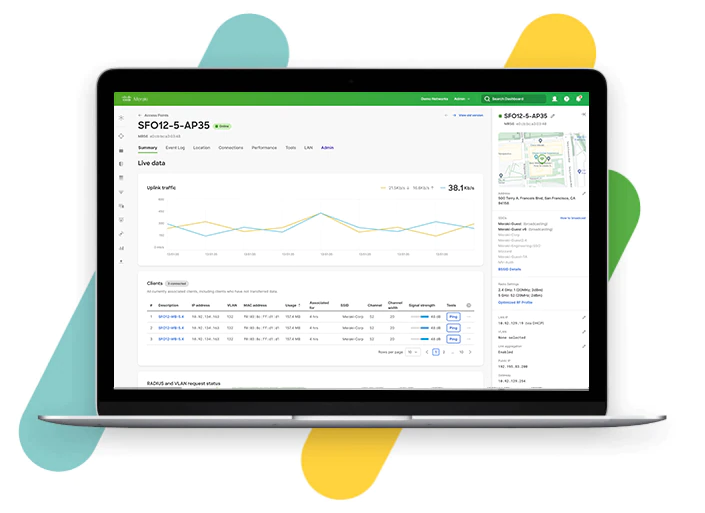MQTT (Message Queuing Telemetry Transport) is a lightweight messaging protocol that helps devices communicate in real-time, especially in IoT (Internet of Things) setups. It works on a publish-subscribe model, allowing devices to share data quickly and securely. It is a machine-to-machine communication protocol.
What is MQTT Telemetry Streaming in Meraki?
In the Meraki Dashboard MQTT telemetry streaming allows you to send live data from Meraki Access Points (MR), Security Cameras (MV), and Sensors (MT) to an external MQTT broker. This feature helps organizations keep an eye on network performance, environmental conditions, and device analytics in real-time.
Once you enable this feature in the Meraki Dashboard, the telemetry data is securely sent to an external MQTT broker for further analysis.
Who is MQTT broker in Meraki?
Cisco Meraki users have the flexibility to configure their own MQTT broker, unlike traditional cloud services where data is sent to a fixed destination. Here’s a simple breakdown of the options available for MQTT brokers:
Cloud-Based Broker (e.g., AWS IoT, Google Cloud IoT, HiveMQ, Eclipse Mosquitto)
- Ideal for large-scale IoT applications and analytics.
- Offers scalability and easy integration with various cloud services.
On-Premises Broker (e.g., Eclipse Mosquitto, EMQX, VerneMQ)
- Best for organizations that want to maintain control over local data.
- Provides low-latency processing, ensuring quick data handling.
- Helps meet data privacy regulations.
Custom Broker Hosted on a Private Server
- Organizations with specific needs can set up their own MQTT broker within a private network.
- Perfect for secure environments where data should not leave the premises.
Defining the Brokers
AWS IoT Core: AWS IoT is a managed cloud service that allows connected devices to easily and securely interact with cloud applications and other devices. It supports MQTT for low-bandwidth, high-latency networks. With AWS IoT, developers can build scalable IoT applications. This leverages features such as device shadows, rules engine and integration with other AWS services to process and act on real time data.
Google Cloud IoT: Google Cloud IoT is a set of fully managed services that enables secure connection and management of IoT devices. It includes Cloud IoT, which supports MQTT for real-time messaging between devices and the cloud. This platform provides seamless integration with Google Cloud services, allowing for powerful data analytics, machine learning and security features to protect data in transit and at rest.
HiveMQ: HiveMQ is a high-performance MQTT broker designed for enterprise use. It focuses on scalability and reliability of IoT applications. It provides a robust platform for connecting devices, enabling real-time communication and data exchange. HiveMQ offers features such as a web-based management interface, extensive monitoring, and MQTT 5.0. This makes it suitable for large-scale IoT deployments while ensuring seamless integration with existing systems and applications.
Eclipse Mosquitto: A lightweight MQTT broker ideal for IoT and smart homes. It supports publish-subscribe messaging with low power usage and works on multiple OS like Windows and Linux. Security features include encryption and authentication. This makes it reliable for industries like healthcare and transportation. Its simplicity and efficiency make it widely used in cloud and industrial automation.
EMQX: A high-performance MQTT broker built for scalability and real-time messaging. It supports millions of connections, message persistence and rule-based processing. Strong security with TLS/SSL encryption and authentication makes it ideal for enterprise IoT deployments. EMQX also offers clustering and load balancing, ensuring high reliability for mission-critical applications.
VerneMQ: A distributed MQTT broker focused on high availability and fault tolerance. Built with Erlang/OTP, it handles millions of connections with low latency. Supports horizontal scaling, robust security and is suitable for finance and industrial applications. VerneMQ ensures seamless integration with both cloud and on-premises environments, making it a great choice for large-scale IoT networks.
How to Configure the MQTT Broker in Meraki ?
After enabling MQTT telemetry streaming in the Meraki Dashboard, users need to specify the endpoint of the MQTT broker that will receive the data. The Meraki devices, such as MR access points and MV cameras, will publish telemetry data to this broker. Applications can then subscribe to the broker for real-time monitoring and analytics.
This setup not only enhances data management but also ensures that organizations can tailor their IoT solutions according to their specific requirements.
Benefits of Using MQTT with Meraki
- Real-Time Network Monitoring – Get immediate insights into connected devices, bandwidth usage, and network performance.
2. IoT & Smart Building Integrations – Use data from Meraki cameras and sensors for tracking people, monitoring the environment, and automating security.
3. Faster Troubleshooting – Identify and fix network issues quickly with continuous data streams.
4. Secure and Scalable – MQTT provides encrypted communication and can support thousands of clients without using much bandwidth.
How to Enable MQTT Telemetry Streaming in Meraki ?
- Log in to the Meraki Dashboard and go to Wireless settings.
- Click on the IOT Radio Settings
- Click on the MQTT tab
- Turn on the setting by clicking Enabled and then click Save.
- Set up an MQTT broker to receive and analyze the telemetry data.
- Use an MQTT client (like Mosquitto, Node-RED, or AWS IoT) to subscribe to the Meraki telemetry topics.
Common Uses of MQTT in Meraki
- Smart Retail – Track foot traffic and improve store layouts using Meraki MV cameras.
- Industrial IoT – Connect Meraki environmental sensors with factory automation systems.
- Enterprise Security – Utilize network telemetry for better threat detection and prevention.
- Smart Cities – Use real-time sensor data for efficient urban planning and managing infrastructure.
The addition of MQTT in the Cisco Meraki Dashboard is a significant advancement for businesses aiming to boost network visibility, IoT automation, and data-driven decision-making. Whether you work in retail, manufacturing, or IT, MQTT telemetry streaming can help you gain valuable real-time insights and automation.
To know more about Cisco Meraki Solutions, click here on Cisco Meraki

